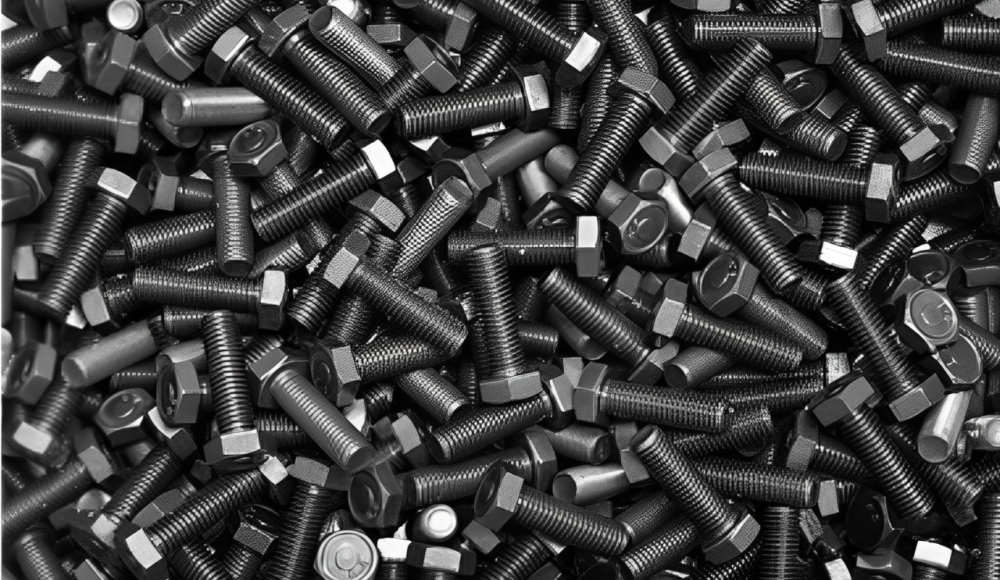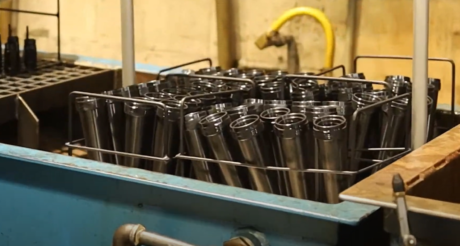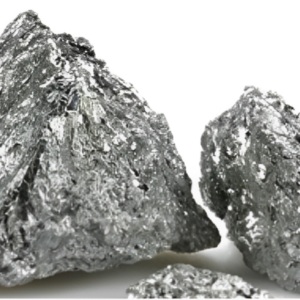Black oxide coating is a well-applied surface treatment that improves the appearance, rust resistance, and strength of metallic products. In this article, we will discuss everything about black oxide coating. We will understand its complete process, advantages, drawbacks as well as uses.
What is Black Oxide Coating?
The Black Oxide Coating Process is a chemical coating that is usually applied on ferrous metals, i.e. steel and iron. It produces a black and corrosion-resistant surface and generally involves a chemical reaction between the metal and an oxidizing agent. These agents may include an alkaline solution along with sodium hydroxide and nitrates. Moreover, this reaction gives a durable, aesthetically pleasing black finish that ultimately improves the metal properties.
Step-by-Step Process of Black Oxide Coating
So, the following are the steps of black oxide coating. Each of these steps ensures the effectiveness of this process.
1. Cleaning
The black coating oxide process starts with cleaning the metal parts to remove the grease, oil, dirt, or debris. So, they do not hinder the adhesion of the coating. This step usually calls for cleaning the parts in an alkaline clean solution. It helps to erode and remove any residuals present on the metal surface. Extreme cleanliness is important during anodizing so no contaminants reside on the surface of the metal. As they can hinder the formation of black oxide coating the surface of the metal.
2. Rinsing
After cleaning, the parts undergo a rinsing phase. Here, the parts are simply washed with water. So, the traces of the cleaning agent can be removed with any traces. This process helps make the surface free from any chemicals to avoid any reaction in further processes. Rinsing in most cases occurs in designed tanks. Here, we can use agitation or ultrasonic waves to increase the efficiency of the rinsing process.
3. Oxidizing
It is the most important step in black oxide coating. Here, the cleaned and rinsed parts are immersed in a hot alkaline solution. It mainly contains sodium hydroxide, nitrates, and nitrites, with the temperature of 275°F to 300°F (135°C to 150°C). This high-temperature solution reacts with the iron in the metal. So, it can form a layer of black iron oxide (magnetite, Fe3O4). The process can take time to 10 to 30 minutes, depending on the desired thickness and uniformity of the coating. Moreover, this step helps create the characteristic black oxide layer. So, it can provide the metal parts with their unique appearance and improved properties.
4. Rinsing
After oxidizing, the parts are rinsed again to remove the oxidizing solution or any traces of it. This rinsing step is very crucial to minimize corrosion. Besides this, it guarantees that the quality of the finish is not interfered with by the remaining chemicals. The parts are rinsed in tanks same as those used in the first rinsing stages. So, they can guarantee that all residuals of oxidizing chemicals are washed off adequately.
5. Sealing
Here, we seal the parts to add more protection and increase the durability of the black oxide coating. In this particular step, the parts are sprayed with rust inhibitor or likewise an oil sealant. Then it will soak through the layers of oxide. Moreover, this additional treatment also provides further protection against moisture and corrosives. It also increases the shelf life and the effectiveness of the coating.
6. Drying
After sealing, all parts are allowed to drying that is needed for use in the next step. This step dries off the parts to remove the remaining moisture. So, they are completely dry and ready to use. Drying may involve air drying, heat drying, i.e. oven drying, or centrifugal drying. There must be no moisture on the part that will interfere with the effectiveness of the black oxide coating.
7. Inspection
Finally, the coated parts are carefully inspected to meet high-quality standards. This is a kind of visual checking to confirm the uniformity and consistency of the parts in the coating. Besides this, it may also include testing for coating thickness, adhesion, and corrosion resistance. Moreover, the inspection tools, i.e. thickness gauges, microscopes, and corrosion testing chambers are often used to verify that the black oxide coating has been applied well or not. It also checks if the coating will perform as expected in its planned application.
Materials Used with Black Oxide Coating
Here are some materials we can use with a black oxide coating.
| Material | Properties | Common Applications |
| Steel | Affordable, strong, durable | Automotive components, machinery parts |
| Stainless Steel | Corrosion-resistant, aesthetic appeal | Medical instruments, kitchenware |
| Iron | Castability, machinability | Decorative items, tools |
| Copper Alloys | Corrosion resistance, durability, aesthetic appeal | Hardware, decorative items |
| Zinc Alloys | Rust prevention, affordability | Fasteners, small components |
What are the Uses or Applications of Black Oxide?
The black oxide coating is used in various industries like:
- Automotive Parts: It helps improve aesthetics and the anti-corrosive characteristics of the engine components and the fasteners.
- Aerospace Components: It offers a protective coat to the aircraft parts.
- Tools and Hardware: Black oxide coating increases the quality of the tools which are made from cut and forged metals.
- Medical Instruments: It is used to make sure that the surface of the tools used in surgeries is clean and free from corrosion.
Can I Do a Black Oxide Finish at Home?
Yes, it is possible to apply a black oxide finish at home. It can be done using cold black oxide kits with proper handling of chemicals and following safety procedures. However, professional coating services are of high quality and give consistent results, so they are more recommended.
What’s the Differences Between Black Oxide and Other Surface Finishes?
The following is a concise table to explain the difference between black oxide and other surface finishes.
| Feature | Black Oxide | Powder Coating | Anodizing | Chroming (Chrome Plating) |
| Appearance | Black, matte, or slightly glossy finish | Glossy, matte, or textured in various colors | Dull, metallic sheen, can be clear or dyed | Bright, reflective, and shiny finish |
| Corrosion Resistance | Good, but requires sealing for the best results | Best, very high resistance | Excellent, especially against corrosion | Good, very high resistance |
| Durability | Moderate, can wear over time | Very durable, resistant to chipping | Very durable, can be hard anodized for extra hardness | Highly durable, resistant to wear |
| Cost | Generally low to moderate | Moderate to high depending on the complexity | Moderate to high depending on thickness | High, due to expensive materials and processes |
| Application | Automotive parts, tools, firearms, electronics | Automotive parts, appliances, outdoor furniture | Aerospace parts, automotive, architectural | Automotive parts, decorative items, tools |
| Thickness | Thin (microns) | Thick (mil) | Thin to moderate (microns) | Thin to moderate (microns) |
| Process Complexity | Moderate | High, requires curing | Moderate, involves electrical processes | High, involves multiple steps including plating |
| Maintenance | Requires regular maintenance and touch-ups | Low maintenance, resistant to fading | Resistant to fading | Low maintenance, resistant to tarnishing |
Advantages of Black Oxide Coating
- It helps protect against rust and corrosion, especially with sealing.
- It gives a sleek, black finish to improve appearance.
- Black oxide increases surface hardness and reduces friction and wear.
- It reduces glare and is quite useful for precision equipment and firearms.
- Black oxide is inexpensive compared to other finishes.
- It adds a thin layer that minimally affects part dimensions.
- Black oxide coating retains lubricants in the porous coating.
Disadvantages of Black Oxide Coating
- It is less effective on its own, so, it may need sealing.
- Black oxide coating can wear off and expose the metal.
- It’s primarily for ferrous metals but not a good option for non-ferrous metals.
- This coating may need regular upkeep and touch-ups.
- Its final finish can vary based on processing conditions.
- It usually requires the handling of chemicals and high temperatures.
Conclusion
In summing up, black oxide coating is quite a cost-effective solution to improve the corrosion resistance of ferrous metal parts. It helps provide a sleek, matte finish and increases the wear resistance and lubrication properties. Moreover, it may need sealing for optimal corrosion protection. Black oxide coating is not a good option for nonferrous materials and high-wear applications. However, it offers various advantages in the case of ferrous metals.
Frequently Asked Questions (FAQs)
Q1. What metals can be coated with black oxide?
It is primarily used on ferrous metals such as steel, iron, and stainless steel.
Q2. How thick is the black oxide coating?
Black oxide coatings are pretty thin averaging from 0. 00002 to 0. 0001 inches (0. 5- 2. 5 microns).
Q3. Can black oxide coating be used on non-ferrous metals?
No, black oxide is not effective on non-ferrous metals such as aluminum, copper, brass, etc.
Q4. Is black oxide coating environmentally friendly?
Yes, black oxide coating is harmless to the external environment. It does not give out any hazardous waste.
Q5. Can black oxide coating withstand high temperatures?
Black oxide coating can degrade at high temperatures. So, its applications are not suitable for high-heat applications.
Contact us for more information.







3 thoughts on “A Complete Guide to Black Oxide Coating-Its Process, Applications and Limitations”